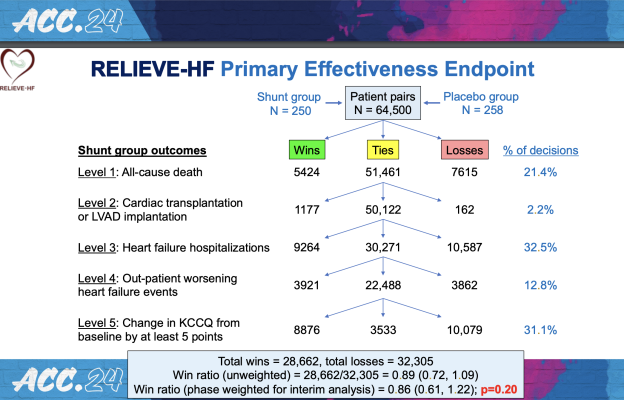
Patients with heart failure who had a small shunt inserted between the heart’s left and right atria did not see any significant benefits overall compared with those who received a placebo procedure after a median of 22 months follow-up, according to a study presented during the first day of the American College of Cardiology Scientific Sessions, ACC.24, in Atlanta, GA.
April 6, 2024 — Patients with heart failure who had a small shunt inserted between the heart’s left and right atria did not see any significant benefits overall compared with those who received a placebo procedure after a median of 22 months follow-up, in a study presented at the American College of Cardiology’s Annual Scientific Session.
The trial, called RELIEVE-HF, is the first randomized placebo-procedure controlled trial of interatrial shunting that included patients with both major types of heart failure: heart failure with reduced ejection fraction (HFrEF) and heart failure with preserved ejection fraction (HFpEF). While the trial did not meet its primary endpoint, it moves the field forward by offering signals that the benefits and risks of interatrial shunts may vary by heart failure type, according to researchers.

Gregg Stone, MD
“When you examine the outcomes in patients with heart failure across a broad range of left ventricular ejection fraction, the Ventura interatrial shunt was extremely safe but did not improve outcomes compared with no treatment. However, in a prespecified analysis, data suggest that the shunt may be beneficial in patients with HFrEF and worsen outcomes in patients with HFpEF,” said Gregg Stone, MD, professor of cardiology and population health sciences at Icahn School of Medicine at Mount Sinai in New York and the study’s first author. “We believe further studies are warranted to confirm the benefits we observed in patients with reduced ejection fraction.”
Heart failure is a condition in which the heart becomes too weak or stiff to effectively pump blood, leading to fatigue, organ damage, shortness of breath and an increased risk of life-threatening cardiovascular events. In HFrEF, the heart muscle becomes weak and does not squeeze as hard as it should. In HFpEF, the left ventricle becomes stiff and does not properly fill with blood.
The Ventura shunt is one of several interatrial devices being tested to aid in the treatment of heart failure. It is designed to form a small connection or passage between the left and right atria to allow blood to leave the left atrium—especially as left atrial pressure rises—thus reducing the pressure in the left atrium and the lungs. High left atrial pressure is a primary cause of shortness of breath and hospitalizations related to heart failure.
The trial randomized 508 patients at 94 sites in North America, Europe, Israel, Australia and New Zealand. All participants had symptomatic heart failure despite taking medications at maximally tolerated doses. About 40% of participants had HFrEF and 60% had HFpEF.
Participants were randomly assigned to undergo a procedure to insert the Ventura shunt or a placebo procedure in which a script was followed with all the same protocols to mask patients as to whether the shunt was inserted. Operators were aware of which procedure each patient received but patients, their families and the rest of the medical teams taking care of the patient after the procedure were not. Researchers tracked outcomes in each participant for at least one year and up to two years.
The results showed no significant difference between groups in terms of the trial’s primary endpoint, a hierarchical composite ranking of death from any cause; heart transplant or left ventricular assist device; heart failure hospitalizations; worsening of outpatient heart failure events; and change in quality of life, as measured using the Kansas City Cardiomyopathy Questionnaire (KCCQ). This hierarchical composite approach for assessing efficacy allows diverse types of outcomes to be incorporated in ranked fashion into an overall “win ratio” reflecting the overall outcome of a drug or device.
In a pre-planned analysis focused on heart failure type, patients with HFrEF who received the shunt were found to have improvements across all outcomes assessed (especially fewer hospitalizations for heart failure), while those with HFpEF who received the shunt were found to have increased rates of death and heart failure hospitalizations. This difference could be attributed to the greater compliance or flexibility of the heart muscle with HFrEF, potentially allowing it to more easily accommodate the extra blood flowing into the right atrium, Stone said.
There were no device-related or procedure-related major adverse cardiovascular or neurologic events in either group during the duration of the trial.
Surprisingly, a marked improvement in quality of life as measured with KCCQ was observed across all groups—including those who received a placebo procedure, both with HFrEF and HFpEF—suggesting that the metric may not be a reliable indicator for quality-of-life outcomes in this context, Stone said.
“There was a tremendous placebo effect,” he said. “These observations, especially the fact that quality of life improved in HFpEF patients who were more likely to be hospitalized for heart failure and had reduced survival after shunt treatment, raise questions about the interpretation of this quality-of-life measure in these kinds of trials.”
Although the observed differences in outcomes among people with different types of heart failure may inform future research and development for interatrial devices, the researchers said that the trial was not powered to show differences in the two types of heart failure. As such, these results should be considered exploratory. They also said that the results may not be applicable to other interatrial shunts beyond the Ventura shunt.
The study was funded by V-Wave Medical.
For more information: www.acc.org


 June 08, 2023
June 08, 2023 
